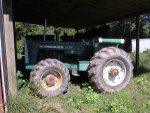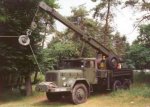RE: multifuel motors used in farm tractors
Found a few more details - I wrote this back in 2003 - have found additional info since, but nothing to contradict what follows.
Copyright David Doyle
In the late 1950s the military was keenly interested in developing powerplants that could run on more than one type of fuel. Aware of this, Continental licensed M-A-N's "whisper engine" design which utilized a combustion method that Continental dubbed the Hyper-Cycle combustion process. After extensive tests this engine was adopted and installed in the G-742 series trucks. This engine was a straight six model LDS-427-2 Multifuel engine, with 427 cubic inch displacement. These engines are able to burn diesel, jet fuel, kerosene, or gasoline, or any combination of these, without adjustment or modification. The cargo truck version of the G-742 series powered by this engine was the M35A1. Initially, trucks with high front axle loadings continued to use the gas engine, due to concern about the considerably higher weight of the Multifuel engine.
The US Military had long desired an engine that was capable of burning a variety of fuels. This was advantageous from both the supply-chain standpoint as well as the capability of utilizing whatever fuels were locally abundant in a given theater of operations.
In the 1950’s Continental Motors Corporation’s engineer Carl Bachle learned of a new engine that had been developed by M-A-N. Dubbed the “whisper engine”, the new engine had been designed by Dr. S. J. Meurer to combat the prevailing (at the time) reputation of M-A-N engines as the loudest on the market.
Bachle made two trips to Germany to learn how the new engine design reduced noise, and in the course of his examination, concluded that the “whisper engine” was also capable of multi-fuel operation.
Bachle struck a licensing arrangement between Continental and M-A-N predicated on M-A-N providing an engine meeting certain testing requirements. The licensing agreement did not require an entrance fee, but rather a royalty arrangement.
The M-A-N engine performed to specification, and Continental Motors redesigned their TD-427 6-cylinder gasoline truck engine into a Multifuel engine, the LDS-427. The new engine was based on the block and crankcase of the gas engine.
In 1958 WORK STARTED ON MULTIFUEL M35E7 & E8. 22 OF EACH BUILT LDS-427-1the M35E7 HAD MANUAL TRANNY.
In 1961 M35E7 CLASSES STANDARD A AS M35A1. GAS ENGINE RETAINED IN APPLICATIONS WITH HIGH FRONT AXLE LOADINGS. EMPTY FRONT AXLE LOAD 6455 (S4)
1961 Studebaker contract in the amount of 27 million for 5030 multifuel deuces.
JUNE 1963 HUPP GETS 24 MILLION MULTIFUEL CONTRACT. THE STATE JOURNAL, LANSING MI JUNE 14, 1964.
JUNE 14, 1964 CONTINENTAL GETS $53,458,539 ORDER FOR MULTIFUEL ENGINES OVER 3 YEARS 9854 1ST YEAR, 8461 2ND, 9011 3RD. ORDER FROM ARMY MOBILITY COMMAND (AMC) THE STATE JOURNAL, LANSING MI JUNE 14, 1964.
"SINCE 1969 THE ARMY HAS COMPETIVELY AWARDED CONTRActs to Hercules Engines, Inc. (formerly White Engines, Inc). of Canton, Oh to produce the 2 1/2 ton truck engine.(s6, pg1)
On June 30, 1987, Army requests EPA approve "Conditional National Security Exemption" from 88 and future standards for purchase of 15,000 2 1/2 ton truck engines over 5 year period. (S6, pg 2)
September 30, 1987 EPA gives one year exemption for 3000 engines. Same time told Army to..."establish a program to develop a cleaner configuration for the current engine." (S6, pg2)
Let the discussions continue.....
David Doyle










